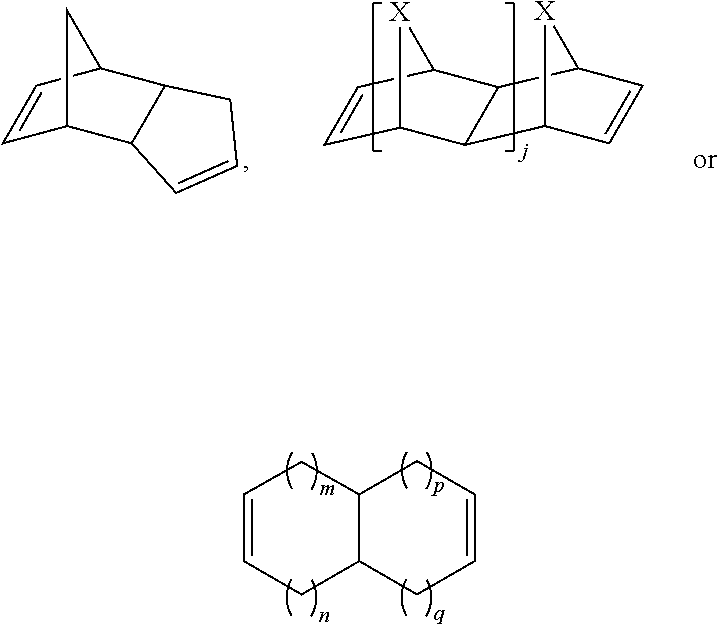Microporous polycyclopentadiene-based aerogels
a polycyclopentadiene and microporous technology, applied in the field of polyolefin aerogels and polyolefin microporous materials, can solve the problems of high energy consumption, inconvenient preparation, and inability to meet the needs of xerogels, and achieve the effect of being easy to prepar
- Summary
- Abstract
- Description
- Claims
- Application Information
AI Technical Summary
Benefits of technology
Problems solved by technology
Method used
Image
Examples
example 1
[0122]First, Ultrene®-99 (3.44 g; high purity DCPD) is weighed into a polypropylene container with a screw cap. Subsequently, toluene (96.45 g) is added and the mixture is stirred until a homogeneous solution results. Next, Prometa® C0716 ruthenium catalyst (0.07 g) is added to the homogeneous solution. After stirring for one minute to evenly disperse the catalyst through the mixture, the reaction mixture is allowed to stand and the time until gelation occurs is recorded. A portion of the sol is transferred into a plastic container containing quartz fiber batting to form a composite sample. The remaining portion in the original polypropylene container is used to form a monolith sample. The monolith and composite samples are gelled by sealing the respective containers to prevent evaporation and the containers are maintained in a quiescent condition to form a polymeric gel. After waiting an additional 30 minutes to ensure the uniform gelation of the mixture, acetone is added to each c...
example 2
[0126]First, Ultrene®-99 (5.73 g, DCPD monomer) is weighed into a polypropylene container with a screw cap. Toluene (94.16 g) is added to the container and the mixture is stirred to obtain a homogeneous solution. Prometa® C0716 ruthenium catalyst (0.11 g) is added to the stirred solution. After stirring thoroughly for one minute to ensure homogeneous dispersion of the catalyst, the same method as described in Example 1 are used for the gelation and aging steps.
[0127]Once the aging process was completed, the wet gel is loaded into a pressure vessel and is supercritically dried using the same method as described in Example 1. The resultant polyDCPD based aerogel is opaque and slightly gray in color. The resultant polyDCPD has a density of 0.069 g / cm3 (shrinkage factor of about 1.38), a surface area of 213 m2 / g, and thermal conductivity coefficient in air at atmospheric pressure of 25.7 mW / m K.
[0128]A quartz fiber-reinforced polyDCPD based aerogel composite is prepared by pouring a por...
example 3
[0129]Ultrene®-99 (8.00 g, DCPD monomer) is weighed into a polypropylene container with a screw cap. Toluene (91.84 g) is added to the container and the mixture is stirred to obtain a homogeneous solution. Prometa® C0716 ruthenium catalyst (0.16 g) is added to the homogeneous solution. After stirring for one minute to ensure a homogeneous dispersion, the sol is divided into a monolithic sample and a quartz fiber reinforced composite sample and each sample is treated with the gelation and aging steps as described in Example 1.
[0130]Once the aging process is complete, the wet gel is loaded into a pressure vessel and then supercritically dried by the method of Example 1. The monolithic polyDCPD based aerogel is opaque and slightly gray in color. The monolithic polyDCPD has a density of 0.1071 g / cm3 (shrinkage factor of about 1.53), a surface area of 245 m2 / g, and a thermal conductivity coefficient in air at atmospheric pressure of 24.7 mW / m K.
[0131]The quartz fiber-reinforced polyDCPD ...
PUM
| Property | Measurement | Unit |
|---|---|---|
| density | aaaaa | aaaaa |
| density | aaaaa | aaaaa |
| density | aaaaa | aaaaa |
Abstract
Description
Claims
Application Information
 Login to View More
Login to View More - R&D
- Intellectual Property
- Life Sciences
- Materials
- Tech Scout
- Unparalleled Data Quality
- Higher Quality Content
- 60% Fewer Hallucinations
Browse by: Latest US Patents, China's latest patents, Technical Efficacy Thesaurus, Application Domain, Technology Topic, Popular Technical Reports.
© 2025 PatSnap. All rights reserved.Legal|Privacy policy|Modern Slavery Act Transparency Statement|Sitemap|About US| Contact US: help@patsnap.com



